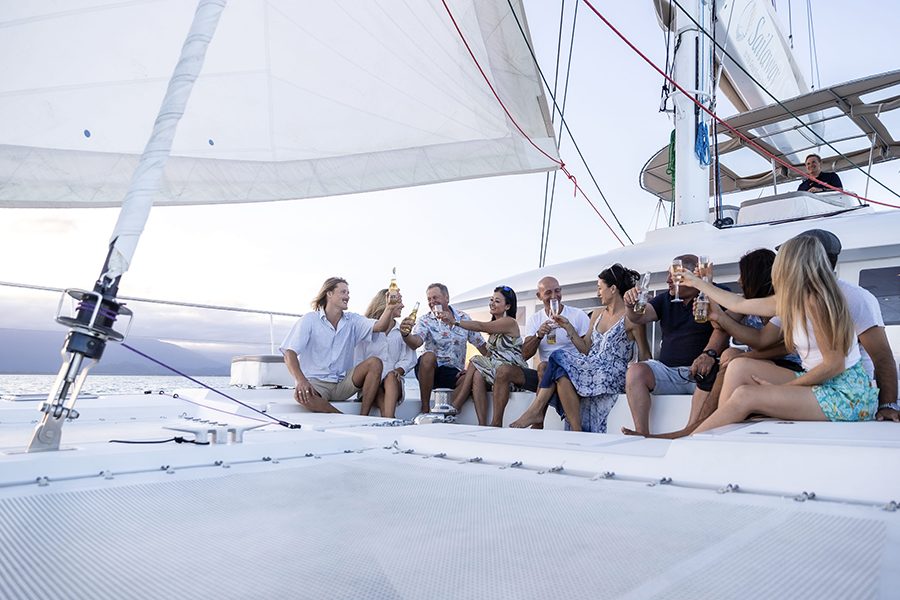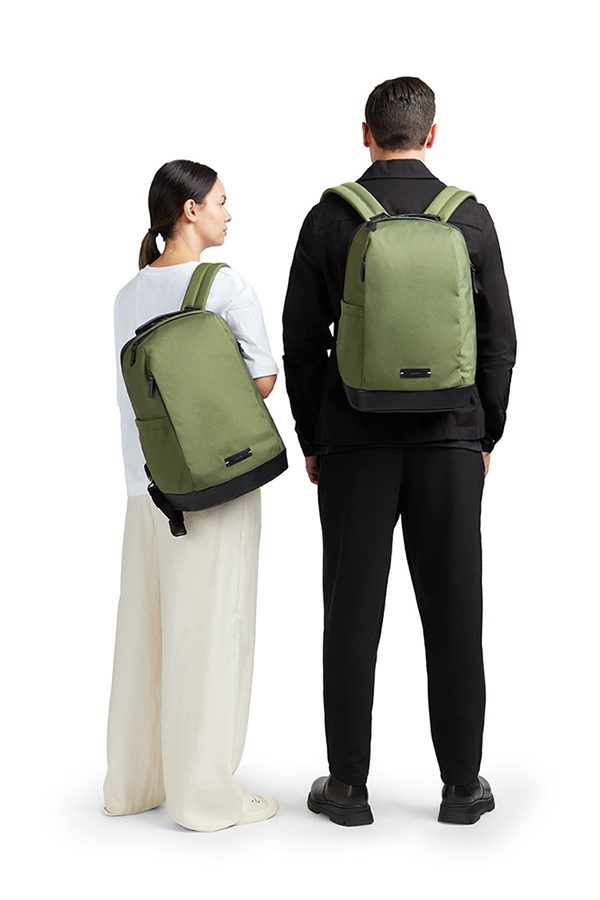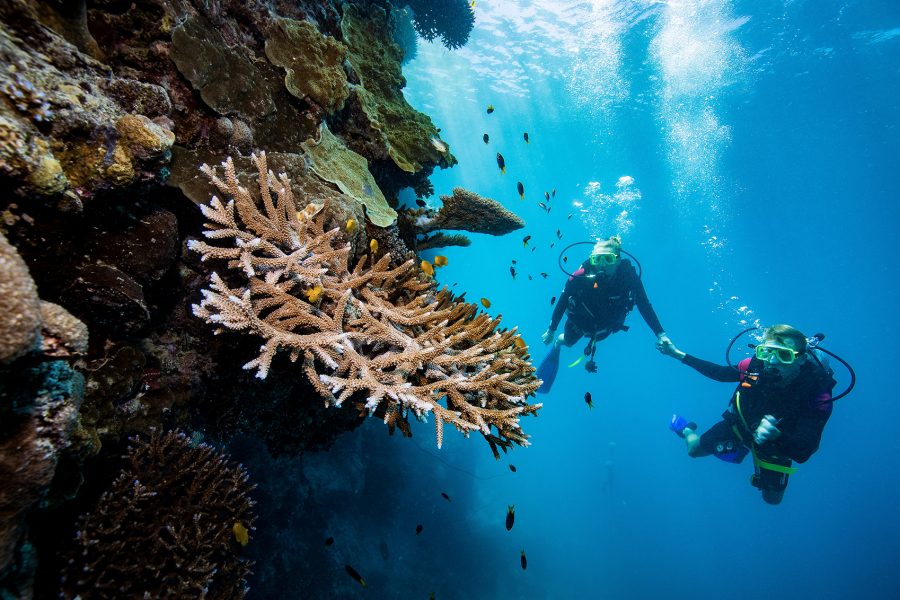Beneath the surface of the Coral Sea, plant life sways in the currents. Turtles forage in seagrass and clacking crustaceans search for prey. During migration season, the ocean floor is bathed with the resonance of humpback whale song. Light refracts, making everything seem larger.
This is the Great Barrier Reef, off the coast of Queensland, Australia – the world’s largest reef ecosystem, spanning 2,300km north to south and covering an area the size of Japan. A system of 3,000 individual reefs, this Unesco World Heritage area is home to countless kinds of creatures, including 1,450 coral species, dolphins and a colossal spectrum of fish. From the tropical city of Cairns and neighbouring Port Douglas, you’ll be able to venture into the great blue beyond on everything from day cruises and snorkelling trips to week-long live-aboard dive safaris.
But it’s not just a matter of grabbing an air tank and diving deep. The reef faces many threats: climate change, coral bleaching, erosion, coastal development, overfishing and pollution have all taken their toll on this spectacular world. Yet those who work closest to this fragile ecosystem are some of its staunchest protectors.
By choosing tour operators, services, hotels and joining scientific excursions which support conservation, you can contribute to the reef’s preservation while taking in its spectacular sights. Here’s what you need to know.
Great Barrier Reef tour operators

Credit: Tourism Australia

Credit: Tourism Australia

Credit: Tourism Australia
Passions of Paradise
Passions of Paradise is part of the Coral Nurturing Program, a partnership between tourism operators and the University of Technology Sydney to install coral nurseries in the reef, supporting resilience and monitoring its diversity.
This tour operator ’s 25m sailing catamarans depart from Cairns on a range of excursions for all ages and abilities. On its Be a Marine Biologist full-day experience, you’ll contribute directly to reef conservation through surveying reef locations, monitoring reef health and submitting your findings to scientific programmes.
Although Passions of Paradise has employed scientists to lead tours since 1997, its marine biologist experience was introduced in response to rising conservation awareness, says CEO Scotty Garden. “Our passengers have been choosing to visit the Great Barrier Reef with Passions of Paradise so they can indirectly support our reef stewardship activities. Many have also been wanting to go that step further and actively participate in an activity to help the reef’s health.”

Credit: Tourism Australia

Credit: Tourism Australia

Credit: Tourism Australia
Sailaway Port Douglas
Another operator participating in the coral programme, Sailaway offers reef monitoring and coral planting expeditions. Striving to further reduce their environmental footprint, the operator recently introduced the world’s first electric-powered glass bottom boat for tours to Low Isles, powered by renewable energy.

Credit: Quicksilver Cruises

Credit: Quicksilver Cruises

Credit: Quicksilver Cruises
Quicksilver Cruises
Quicksilver Cruises is North Queensland’s largest day trip operator, running tours to more remote locations such as the Agincourt Reefs. Far from the usual tourist beat, marine life thrives here, from colourful coral gardens to giant Māori wrasse. You can join snorkel tours led by marine biologists, view shallow reefs from a semi-submersible boat and underwater observatory, or take an introductory scuba diving lesson.

Credit: Great Barrier Reef Legacy

Credit: Coral Expeditions

Credit: Great Barrier Reef Legacy
Local conservation
Vast swathes of the reef have been impacted by bleaching, a phenomenon whereby the coral sheds its symbiotic algae and loses its pigment in response to stressors including rising sea temperatures. This puts the coral at risk of starvation and disease, and recovery can take decades.
The governmental Great Barrier Reef Marine Park Authority monitors reef health, manages permits for operators and runs Eye on the Reef, a citizen science project to gather information on the reef and any incidents. In 2022, Citizens of the Reef –an alliance of First Nations sea rangers, tourism operators and scientists –launched The Reef Cooperative : a conservation project and training programme aimed at delivering large-scale restoration.
Meanwhile, Great Barrier Reef Legacy , a nonprofit social enterprise, has established its Coral Biobank, housing 415 hard coral species at a new facility at Crystalbrook Marina in Port Douglas. In 2021, they partnered with Cairns-based Coral Expeditions , enabling passengers to witness the collection of 50 coral species to add to the Coral Biobank on its first Citizen Science Expedition.
As much of the damage to the reef is caused by human activity – whether by individuals, such as littering or breaking off pieces of coral, or industrial, such as agricultural run-off and sedimentation from logging – education is an essential component of tourism in the Great Barrier Reef.
“It’s vitally important to preserve our natural assets for future generations and encourage environmental ambassadors.” says Sailaway owner Steve Edmondson. “Our goal is for around two million annual visitors to the Great Barrier Reef to take up their own climate change action.”
The only piece of the reef you should take home is the determination to protect it for the future.

Credit: Lojel

Credit: Barrel

Credit: Speedo
What to pack
Minimising your impact on the Great Barrier Reef begins with responsible travel planning – and packing. Beyond swimwear and a good pair of flip flops or water shoes , you’ll need a backpack to store your belongings on your tour. If you’re planning to go snorkelling, a waterproof phone bag is also a good idea. For more travel essentials, head to the Cathay Shop.
More inspiration
Cairns travel information
- China – the Chinese Mainland, Hong Kong SAR, Macao SAR and Taiwan Region
- Hong Kong SAR - English
- Chinese Mainland (China) - English
- Taiwan, China - English
- 香港特別行政區 - 繁體中文
- 中国內地 - 简体中文
- 中國台灣 - 繁體中文
- Africa
- South Africa - English
- Asia
- Bangladesh - English
- Korea - English
- Singapore - English
- Cambodia - English
- 한국 - 한국어
- Sri Lanka - English
- India - English
- Malaysia - English
- Thailand - English
- Indonesia - English
- Maldives - English
- ประเทศไทย - ภาษาไทย
- Indonesia - Bahasa Indonesia
- Myanmar - English
- Vietnam - English
- Japan - English
- Nepal - English
- Việt Nam - tiếng Việt
- 日本 - 日本語
- Philippines - English
- Australasia
- Australia - English
- New Zealand - English
